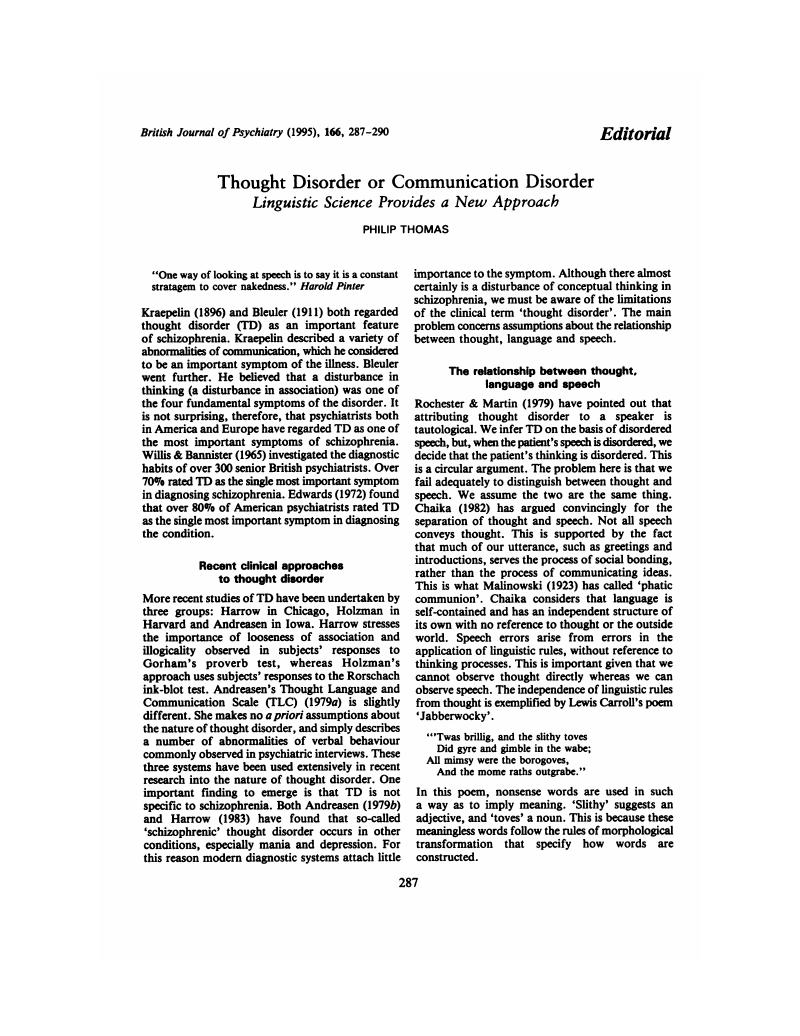Crossref Citations
This article has been cited by the following publications. This list is generated based on data provided by Crossref.
MUIR, NIKI
1995.
Communication and the mentally ill patient.
International Journal of Language & Communication Disorders,
Vol. 30,
Issue. S1,
p.
125.
Haddock, Gillian
Wolfenden, Melanie
Lowens, Ian
Tarrier, Nicholas
and
Bentall, Richard P.
1995.
Effect of Emotional Salience on Thought Disorder in Patients with Schizophrenia.
British Journal of Psychiatry,
Vol. 167,
Issue. 5,
p.
618.
Szasz, Thomas
1996.
‘Audible Thoughts’ and ‘Speech Defect’ in Schizophrenia.
British Journal of Psychiatry,
Vol. 168,
Issue. 5,
p.
533.
Thomas, Philip
Kearney, Gabby
Napier, Elizabeth
Ellis, Elin
Leudar, Ivan
and
Johnston, Margaret
1996.
Speech and Language in First Onset Psychosis Differences Between People with Schizophrenia, Mania, and Controls.
British Journal of Psychiatry,
Vol. 168,
Issue. 3,
p.
337.
Emerson, Joyce
and
Enderby, Pam
1996.
Prevalence of speech and language disorders in a mental illness unit.
International Journal of Language & Communication Disorders,
Vol. 31,
Issue. 3,
p.
221.
Weisbrod, Matthias
Maier, Sabine
Harig, Sabine
Himmelsbach, Ulrike
and
Spitzer, Manfred
1998.
Lateralised semantic and indirect semantic priming effects in people with schizophrenia.
British Journal of Psychiatry,
Vol. 172,
Issue. 2,
p.
142.
Byrne, Marie E.
Crowe, Thomas A.
and
Griffin, Pamela S.
1998.
Pragmatic Language Behaviors of Adults Diagnosed with Chronic Schizophrenia.
Psychological Reports,
Vol. 83,
Issue. 3,
p.
835.
BYRNE, MARIE E.
1998.
PRAGMATIC LANGUAGE BEHAVIORS OF ADULTS DIAGNOSED WITH CHRONIC SCHIZOPHRENIA.
Psychological Reports,
Vol. 83,
Issue. 7,
p.
835.
Newby, David
1998.
‘Cloze’ procedure refined and modified.
British Journal of Psychiatry,
Vol. 172,
Issue. 2,
p.
136.
Thompson, I. M.
and
Copolov, D. L.
1998.
The psycholinguistics of auditory hallucinations.
Aphasiology,
Vol. 12,
Issue. 10,
p.
919.
Moser, R.Kevin
Cienfuegos, Angel
Barros, Jorge
and
Javitt, Daniel
2001.
Auditory distraction and thought disorder in chronic schizophrenic inpatients.
Schizophrenia Research,
Vol. 51,
Issue. 2-3,
p.
163.
Neziroglu, Fugen
and
Stevens, Kevin P.
2002.
Cognitive Approaches to Obsessions and Compulsions.
p.
183.
Guigo-Banovic, I
Naudin, J
Collet, R
and
Pédinielli, J.-L
2003.
Le rapport au temps et à l’espace dans les récits de l’expérience subjective des voix.
Annales Médico-psychologiques, revue psychiatrique,
Vol. 161,
Issue. 10,
p.
774.
Clegg, Judy
Brumfitt, Shelagh
Parks, Randolph W.
and
Woodruff, Peter W. R.
2007.
Speech and language therapy intervention in schizophrenia: a case study.
International Journal of Language & Communication Disorders,
Vol. 42,
Issue. S1,
p.
81.
Barrera, Alvaro
McKenna, Peter J.
and
Berrios, German E.
2008.
Two new scales of formal thought disorder in schizophrenia.
Psychiatry Research,
Vol. 157,
Issue. 1-3,
p.
225.
Banovic, I.
Gilibert, D.
Gimenez, G.
and
Jebrane, A.
2009.
Mise en scène et origine perçue des voix hallucinées dans des discours de patients schizophrènes.
Annales Médico-psychologiques, revue psychiatrique,
Vol. 167,
Issue. 10,
p.
736.
Bordas, Carlos Salavera
and
Sanclemente, Miguel Puyuelo
2010.
Aspectos semánticos y pragmáticos en personas con esquizofrenia.
Revista de Logopedia, Foniatría y Audiología,
Vol. 30,
Issue. 2,
p.
84.
Hella, Pertti
Niemi, Jussi
Hintikka, Jukka
Otsa, Lidia
Tirkkonen, Jani‐Matti
and
Koponen, Hannu
2013.
Disordered semantic activation in disorganized discourse in schizophrenia: a new pragma‐linguistic tool for structure and meaning reconstruction.
International Journal of Language & Communication Disorders,
Vol. 48,
Issue. 3,
p.
320.
Esmaeelpour, Elmira
and
Ghatreh, Fariba
2019.
LEXICAL COHESION IN SADEGH HEDAYAT’S LETTERS: THE EFFECT OF BIPOLAR MOOD DISORDER.
IJASOS- International E-journal of Advances in Social Sciences,
p.
908.
Niedźwiadek, Sylwia
and
Szulc, Agata
2024.
Schizophasia and Cognitive Impairment in Schizophrenia: A Literature Review.
Brain Sciences,
Vol. 15,
Issue. 1,
p.
25.




eLetters
No eLetters have been published for this article.